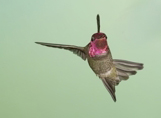
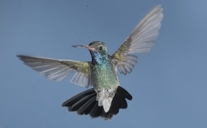
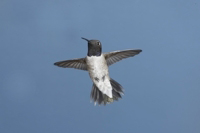





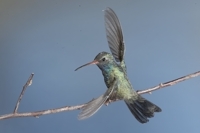

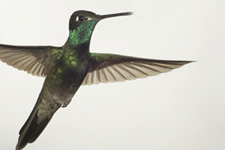

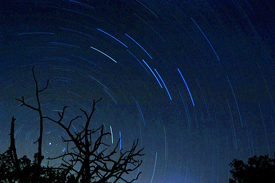
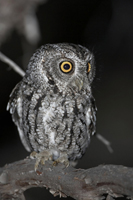
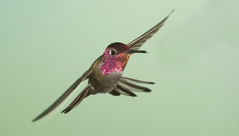 The Best Ever. If
I had to sum up our Arizona High-Speed Flash Hummingbird Photo
Shoots in just three words, 'the best ever' would more than suffice.
This year we did four hummingbird shoots, each offering four full
days of shooting hummingbirds, with five different hummingbird
sets. This year, for a variety of reasons, everything came together
to produce the most productive and exciting shooting we've ever
had. Why? We'll get to that in a moment.
The Best Ever. If
I had to sum up our Arizona High-Speed Flash Hummingbird Photo
Shoots in just three words, 'the best ever' would more than suffice.
This year we did four hummingbird shoots, each offering four full
days of shooting hummingbirds, with five different hummingbird
sets. This year, for a variety of reasons, everything came together
to produce the most productive and exciting shooting we've ever
had. Why? We'll get to that in a moment.
All of our hummingbird shoots have been located at the Santa Rita Lodge in Madera Canyon, about forty miles south of Tucson in southern Arizona. Last year, we worried that one of Arizona's worst forest fires, one that burned many areas in the Santa Rita mountains, would roll through Madera Canyon as well, consuming the Lodge and the beautiful riparian forest that surrounds it. Fortunately, the fire was contained and the Canyon and the Lodge were saved. However, much of Arizona was, and is, in a severe drought, and as we drove up the winding two-lane road that leads into the canyon we saw plenty of evidence of the drought. There were no flowers lining the roadsides, not even the European Bull Thistles that we often used for disguising our hummingbird feeder tubes. How would this dryness and lack of flowers affect our shooting?
 While I had a bit
of concern, I wasn't too worried. The Canyon was home to a large
number of hummingbirds and, flowers or no flowers, this is where
these birds lived. Hummingbirds do not exist solely on flower
nectar or sugar water, but instead they feed on small insects,
aphids, spiders, and use the sweets of nectar or the sugar from
a feeder as a supplement. I knew the insects would still be present,
and we'd be supplying the sugar water, so I figured we should
be fine.
While I had a bit
of concern, I wasn't too worried. The Canyon was home to a large
number of hummingbirds and, flowers or no flowers, this is where
these birds lived. Hummingbirds do not exist solely on flower
nectar or sugar water, but instead they feed on small insects,
aphids, spiders, and use the sweets of nectar or the sugar from
a feeder as a supplement. I knew the insects would still be present,
and we'd be supplying the sugar water, so I figured we should
be fine.
What I didn't expect, nearly immediately after setting up our feeders, was an invasion of Africanized honeybees, that so swarmed our feeders that within hours of discovering the feeders we had golf ball-sized clusters of bees at the tip of our feeding tubes. Hummingbirds, attempting to feed, were repelled by the impenetrable swarm. This was serious! Fortunately, we've had bee problems in the past and we took our usual steps, which included a rather tedious process of setting up decoy feeders for the bees, and within days of the invasion our feeders were virtually bee-free.
 So
our hummingbird shoots started out on a different note from other
years, but things, from there, went rapidly uphill in a very positive
fashion. Three species of hummingbirds regularly visit the feeders
- Broad-billed, the most common; Black-chinned, noisy and tiny,
the second most common; and the Magnificent, the stealth bomber
of the hummers, nearly twice the size of a Broad-billed, shy,
and fast in its feeding. In a normal year these three species
provide more than enough shooting opportunities to capture hummingbirds
in a huge variety of flying poses. But this year was different.
So
our hummingbird shoots started out on a different note from other
years, but things, from there, went rapidly uphill in a very positive
fashion. Three species of hummingbirds regularly visit the feeders
- Broad-billed, the most common; Black-chinned, noisy and tiny,
the second most common; and the Magnificent, the stealth bomber
of the hummers, nearly twice the size of a Broad-billed, shy,
and fast in its feeding. In a normal year these three species
provide more than enough shooting opportunities to capture hummingbirds
in a huge variety of flying poses. But this year was different.
This year, three other species graced our feeders for varying times in various sessions. The first to appear was a spectacular Anna's Hummingbird, a male in full breeding plumage wearing a glistening helmet of metallic rose red feathers. It first appeared at our Set No. 1, but quickly adopted and claimed Set No. 2 where, for nearly ten days, it visited that shooting station almost every hour, and sometimes as frequently as every 15-20 minutes. Everyone present for the Hummingbird shoot occurring during that time photographed this extremely colorful bird.
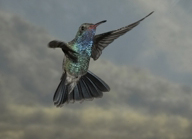 Several
immature Broad-tailed Hummingbirds visited the feeders as well,
although, as immatures their color wasn't especially striking
and, for some, the birds may have been confused with female or
immature Broad-billed Hummingbirds. Still, for the birders amongst
us, the species was a welcome addition. But not as much as our
sixth species.
Several
immature Broad-tailed Hummingbirds visited the feeders as well,
although, as immatures their color wasn't especially striking
and, for some, the birds may have been confused with female or
immature Broad-billed Hummingbirds. Still, for the birders amongst
us, the species was a welcome addition. But not as much as our
sixth species.
 One of the rarest
of Arizona's hummingbirds, one that has been recorded only a time
or two in Madera Canyon, so rare that, it fact, it isn't mentioned
as a species to seek in that particular canyon, the White-eared
Hummingbird is occasionally seen in some of the more eastern mountain
ranges of southeastern Arizona. This year, one of our participants,
shooting at Set 5 called me over to look at a bird he thought
was different from the more common, and somewhat similar, Broad-billeds
he'd been shooting. I'd never seen a White-eared before -- a life
bird to-be, but after seeing his image on his laptop and confirming
it with a field guide, I knew we had a new species for our shoots
- this extremely rare White-eared! Over the next two sessions
the bird appeared daily, and, over time, visited each of the five
hummingbird sets we had for shooting. Everyone got photos and
although to a non-birder a White-eared isn't any more spectacular
a photo than the more common Broad-billed, everyone was caught
up in the excitement of getting a shot -- and everyone did!
One of the rarest
of Arizona's hummingbirds, one that has been recorded only a time
or two in Madera Canyon, so rare that, it fact, it isn't mentioned
as a species to seek in that particular canyon, the White-eared
Hummingbird is occasionally seen in some of the more eastern mountain
ranges of southeastern Arizona. This year, one of our participants,
shooting at Set 5 called me over to look at a bird he thought
was different from the more common, and somewhat similar, Broad-billeds
he'd been shooting. I'd never seen a White-eared before -- a life
bird to-be, but after seeing his image on his laptop and confirming
it with a field guide, I knew we had a new species for our shoots
- this extremely rare White-eared! Over the next two sessions
the bird appeared daily, and, over time, visited each of the five
hummingbird sets we had for shooting. Everyone got photos and
although to a non-birder a White-eared isn't any more spectacular
a photo than the more common Broad-billed, everyone was caught
up in the excitement of getting a shot -- and everyone did!
 As
noted, we had Five hummingbird setups for our six shooting participants.
These are scattered around on the grounds of the lodge to provide
enough space between feeders to minimize competition and to practically
guarantee that at least some of the feeders will always be seeing
action. If you've read our 2006's
brochure on this shoot, you may know that we rotate our shooters
through each of the five sets which insures that everyone gets
some great shooting. In contrast, if you traveled to any one of
the numerous hummingbird lodges in southern Arizona and New Mexico
and set up your own feeder and flash setup, its possible that
not a single bird might visit your feeder during the course of
your stay. Why not? Well, if other feeders are in place and if
the birds are accustomed to visiting those feeders, they've established
a habit that need not be broken. There's no reason to investigate
another feeder. In time, no doubt, a few birds would -- they always
do, but how long might that take? A day, a week, longer? I know
this from personal, very frustrating experience, and I've set
up for hummingbirds at other lodges where I was competing against
established feeders. I ran out of time before any birds appeared.
As
noted, we had Five hummingbird setups for our six shooting participants.
These are scattered around on the grounds of the lodge to provide
enough space between feeders to minimize competition and to practically
guarantee that at least some of the feeders will always be seeing
action. If you've read our 2006's
brochure on this shoot, you may know that we rotate our shooters
through each of the five sets which insures that everyone gets
some great shooting. In contrast, if you traveled to any one of
the numerous hummingbird lodges in southern Arizona and New Mexico
and set up your own feeder and flash setup, its possible that
not a single bird might visit your feeder during the course of
your stay. Why not? Well, if other feeders are in place and if
the birds are accustomed to visiting those feeders, they've established
a habit that need not be broken. There's no reason to investigate
another feeder. In time, no doubt, a few birds would -- they always
do, but how long might that take? A day, a week, longer? I know
this from personal, very frustrating experience, and I've set
up for hummingbirds at other lodges where I was competing against
established feeders. I ran out of time before any birds appeared.
By rotating our participants, we could pretty much insure that everyone would have luck at some time of the day. It's always possible that a particular feeder, or even two, is slow or virtually deserted for a period of time, but photographers at that station at least have the solace that soon they'd be rotated to another spot. This happened at our Set No. 3 for one of our middle hummingbird shoots -- no one was having luck there, but on our last hummingbird session that Set No. 3 was the hottest of them all. It changes like that, which may not be much comfort for someone on a set that's not 'hot' at a given time, but it happens.
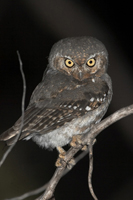


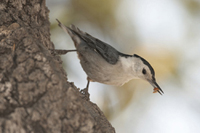 As
usual, we also set up our 'Dead Tree Forest' where, each morning,
Mary would seed the predrilled holes we'd made in our trees with
peanuts that the Acorn Woodpeckers and Mexican Gray-breasted Jays
fed on so avidly. We plant a number of tree stumps in an open
area perfect for early morning shooting, making our Dead Tree
Forest the spot to be right after breakfast each morning. When
we leave -- this year, nearly eight weeks later, we remove these
trees, which is always a depressing time for us and, I'd suspect,
a bit confusing for the birds. Where'd those perches and peanuts
go? Planting and removing the trees each year certainly requires
some work, but it frees up the Lodge's grounds when we're not
there and, perhaps more importantly, it insures that our participants
enjoy a very unique shooting opportunity normally not available
to photographers in Madera Canyon.
As
usual, we also set up our 'Dead Tree Forest' where, each morning,
Mary would seed the predrilled holes we'd made in our trees with
peanuts that the Acorn Woodpeckers and Mexican Gray-breasted Jays
fed on so avidly. We plant a number of tree stumps in an open
area perfect for early morning shooting, making our Dead Tree
Forest the spot to be right after breakfast each morning. When
we leave -- this year, nearly eight weeks later, we remove these
trees, which is always a depressing time for us and, I'd suspect,
a bit confusing for the birds. Where'd those perches and peanuts
go? Planting and removing the trees each year certainly requires
some work, but it frees up the Lodge's grounds when we're not
there and, perhaps more importantly, it insures that our participants
enjoy a very unique shooting opportunity normally not available
to photographers in Madera Canyon.
We also set up a water set, a man-made waterhole we build on top of saw-horses to provide a comfortable, near water-level perspective from a standing position. This year's set was, unquestionably, the best I've ever done -- it looked like a waterhole straight from lower down in the Canyon, and the bird activity there was great. We had Bridled Titmice, White-breasted Nuthatches, Mexican Jays, Acorn Woodpeckers, Black-headed Grosbeaks, Pine Siskins, Lesser Goldfinches, Arizona Woodpeckers, Lark Sparrows, and House Finches regularly visit the water set, which provided wonderful shooting through the afternoon as an alternative to shooting hummingbirds, and a great position for whomever was 'off' on a rotation.
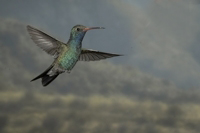 This
year, we also erected something brand new, the Ultimate Woodpecker
Set, where I'd set up several great logs, all in a parallel row,
baited with suet for close shooting of Arizona Woodpeckers, Acorn
Woodpeckers, and the jays, nuthatches, grosbeaks, and titmice
that also raided the set. This set was placed very close to our
room and I'd built this so that I, and our participants, could
photograph the rather uncommon Arizona Woodpecker. This bird grew
so tame that I could walk within yards of the set as I went for
my camera gear, but most of the time, by the time I did so, the
bird was finished eating! I succeeded a couple of times, but everyone
else had ample opportunities for the other species as well.
This
year, we also erected something brand new, the Ultimate Woodpecker
Set, where I'd set up several great logs, all in a parallel row,
baited with suet for close shooting of Arizona Woodpeckers, Acorn
Woodpeckers, and the jays, nuthatches, grosbeaks, and titmice
that also raided the set. This set was placed very close to our
room and I'd built this so that I, and our participants, could
photograph the rather uncommon Arizona Woodpecker. This bird grew
so tame that I could walk within yards of the set as I went for
my camera gear, but most of the time, by the time I did so, the
bird was finished eating! I succeeded a couple of times, but everyone
else had ample opportunities for the other species as well.
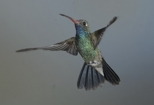 My friend Dave Northcott
visited and set up an aquarium that we stocked with unusual aquatic
insects like water scorpions, giant water bugs, backswimmers,
waterboatmen, and whirligig beetles, and several photographers
over the course of the numerous shoots took advantage of the tank,
using their own flash equipment, or Dave's, to shoot the insects.
My friend Dave Northcott
visited and set up an aquarium that we stocked with unusual aquatic
insects like water scorpions, giant water bugs, backswimmers,
waterboatmen, and whirligig beetles, and several photographers
over the course of the numerous shoots took advantage of the tank,
using their own flash equipment, or Dave's, to shoot the insects.
Another friend, Bill Forbes, lives nearby near Elephant Head, a community just south of the Canyon, five miles as the hummingbird flies, thirty minutes by car. Bill has set up a wonderful high desert water hole shooting opportunity for photographers, and charges a modest daily fee for no more than two photographers to shoot in his blinds. Unfortunately, I didn't get to shoot at Bill's until after our first hummingbird shoots were finished, so I could not rabidly, enthusiastically endorse, urge, exhort folks to go down and shoot at Bill's, but I did so after I checked it out. Bill discounted our groups greatly, and folks were rewarded with some spectacular shots. This month's Tip of the Month will say more on that, so I'll refer you to that rather than continue here. However, next year, Bill's Pond will be incorporated as a part of the shoot so everyone will have a chance to photograph there.
A few groups expressed particular interests, like photographing Elf Owls or going down to the desert to photograph Banner-tailed Kangaroo Rats, and we had some wonderful shooting opportunities with both. The Rats were particularly intriguing -- when one thinks of 'rats' one no doubt gets the wrong impression, for although the animals are rodents they resemble African Springhares or Australian Kangaroos as they hop about on large hindlegs, keeping their tiny forelimbs tucked up tightly to their chest, like furry Tyranosauruses. Kangaroos rats are nocturnal, but it is incredible how some become habituated quickly and become very tame and almost bold. While shooting them made for a long, long day (the shoots going until 10PM or later), it was certainly rewarding.
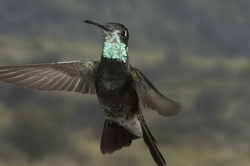 In
four Hummingbird shoots, we had only four film shooters; the rest
were digital. This provided us freedom in shooting that we never
had before, as disguising a feeding tube was no longer a critical
issue. Accordingly, without question, our poses, opportunities,
shooting frequencies, any indices of what makes a great shoot,
was better than it had ever been before. On two of our lunch periods
we then reviewed Photoshop options to maximize the digital potential
of these shots -- mini-workshops that we're going to incorporate
into next year's shoots.
In
four Hummingbird shoots, we had only four film shooters; the rest
were digital. This provided us freedom in shooting that we never
had before, as disguising a feeding tube was no longer a critical
issue. Accordingly, without question, our poses, opportunities,
shooting frequencies, any indices of what makes a great shoot,
was better than it had ever been before. On two of our lunch periods
we then reviewed Photoshop options to maximize the digital potential
of these shots -- mini-workshops that we're going to incorporate
into next year's shoots.
While we had no equipment failures, I think it's important to note what's required for the sets and as backup equipment should anything go wrong. Four of our five sets had a three flash system for lighting, one set had five flashes. Every one of these sets was supported by at least two complete backup systems should equipment be broken or damaged. I drove out to Arizona with forty-five to fifty electronic flash units, almost twenty Bogen Magic Arms or Articulating Arms, 35 Bogen Super Clamps, four Bogen AutoPoles, thirty Electronic Slave Units, a dozen Light Stands, 10 different photographic backgrounds, 15 poster board backgrounds, and all the cables, multi-PC blocks, and miscellaneous equipment I might need. Additionally, we store the lumber required for the sets and water sets in Arizona, and, when we packed that up at the end of the shoot, we had over a pickup truck's load of lumber, saw horses, props, etc. As you may guess, a lot goes into this!

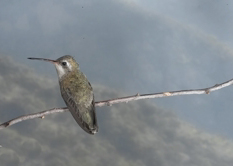
While this is a lot of work for us, it means that all our participants need do is show up with the appropriate lenses and a hotshoe flash to trigger our flash systems. No other gear is required, and we always have spare hotshoe flashes for those that don't.
Next year, we plan to return to Madera Canyon for more Hummingbird Shoots and two more Arizona Digital-Complete Nature Photo Courses. Some of our participants this year stayed for both -- learning what they needed to know for digital shooting, workflow, basic Photoshop skills, and, most importantly, skilled camera handling, and then enjoyed a more restive week shooting the hummingbirds. We will be doing both next year, alternating the sessions to provide that opportunity again. If you're interested, I'd suggest you contact our office ASAP as these trips should fill extremely quickly. We do not have prices or dates firmly set as I write this, but if you're interested, make sure you contact our office so we can contact you first, before we do a general posting.